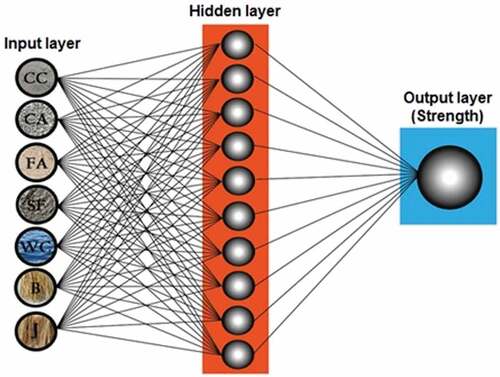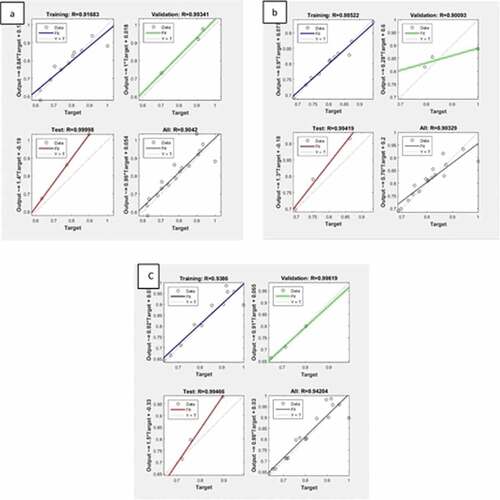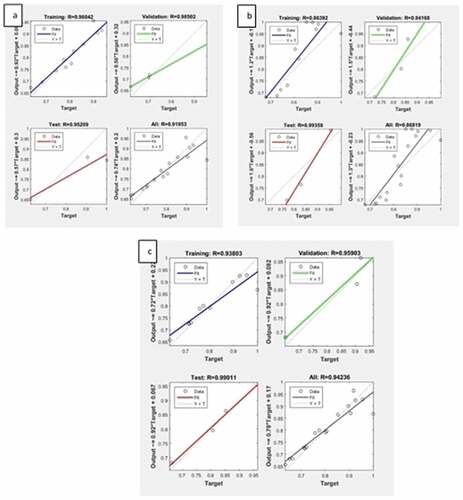 ?Mathematical formulae have been encoded as MathML and are displayed in this HTML version using MathJax in order to improve their display. Uncheck the box to turn MathJax off. This feature requires Javascript. Click on a formula to zoom.
?Mathematical formulae have been encoded as MathML and are displayed in this HTML version using MathJax in order to improve their display. Uncheck the box to turn MathJax off. This feature requires Javascript. Click on a formula to zoom.ABSTRACT
The aim of the effort is to estimate the effect of jute and bamboo fibers with silica fume (SF) of different proportions on mechanical properties of concrete. Cube, cylinder and prism specimens are tested to determine the compressive, split tensile and flexural strength at 14 and 28 days of curing. To verify the experimental findings, further Artificial Neural Network (ANN) analysis is conducted. The study employs neural network (NN), such as the Neural Network-Leven Berg–Marquardt and the Neural Network Gradient Descent. In this investigation, feed-ahead lower back promulgation neural networks were employed. The NN predicted values are validated with actual values and the variation is found to be within 10% only. The predicted ANN results are compared with existing Response Surface Methodology model. Under compressive, split tensile and flexural load, the broken surface is examined at a smaller-scale level with a scanning electron microscope (SEM). The experimental results show that concrete with 0.5% bamboo fibers and 0.5% jute fibers with 10% SF had higher influence on the mechanical properties of concrete. When comparing ANN results, the suggested ANN model showed high level of accuracy in estimating the mechanical properties of natural-fiber-reinforced concrete. SEM examination displayed the failure pattern of concrete and fibers.
摘要
目的是评估黄麻和竹纤维与不同比例的硅粉 (SF) 对混凝土力学性能的影响. 测试立方体、圆柱体和棱柱试样,以确定14天和28天固化时的抗压强度、劈裂抗拉强度和弯曲强度. 为了验证实验结果,进行了进一步的人工神经网络 (ANN) 分析. 该研究采用神经网络 (NN),如神经网络Leven-Berg-Marquardt (NN-LM) 和神经网络梯度下降 (NN-GD) (NN-GG). 在本研究中,采用了前馈-下反馈公布神经网络. NN预测值与实际值进行了验证,发现其变化仅在10%以内. 预测的ANN结果与现有的响应面方法 (RSM) 模型进行了比较. 在压缩、劈裂拉伸和弯曲载荷下,用扫描电子显微镜 (SEM) 在较小尺度上检查断裂表面. 试验结果表明,0.5%竹纤维、0.5%黄麻纤维和10%SF对混凝土力学性能的影响较大. 通过与人工神经网络结果的比较,所提出的人工神经网络模型具有较高的精度,可用于估计天然纤维混凝土的力学性能. SEM检查显示了混凝土和纤维的破坏模式.
Introduction
Concrete is one of the most widely used construction materials in the world, even though it is weak in tension. Many efforts have been made to enhance the behavior of concrete under tension. One such approach is addition of additive such as cementitious materials and fibers in concrete. The inclusion of fibers, particularly natural fibers such as jute and bamboo fibers, can increase the tensile strength of concrete (Khan and Ali Citation2019). Sustainable infrastructure development and concerns on environmental sustainability have paved way for the adoption of natural fibers in concrete (Kundu, Chakraborty, and Chakraborty Citation2018; Momoh and Israel Osofero Citation2019). Reinforced cement concrete composite consists of natural fibers with small diameter and discontinuous, discrete characteristic fibers scattered arbitrarily all through the concrete matrix (Islam and Ahmed Citation2018). Among the diverse natural fibers, bamboo and jute fibers can withstand tensile and flexural loads as well as impact load when compared to other fibers (Sen and Reddy Citation2011). Jute fibers are widely used in aerospace, automotive, maritime, and sporting industries due to their better properties such as low density, stiffness and light weight (Ajith, Kumar, and Elayaperumal Citation2014). On the other hand, the natural jute fiber in concrete can be the efficient material to reinforce the concrete that helps in the improvement of properties (Zakaria et al. Citation2017; Sridhar, Gobinath, and Serkan Kırgız Citation2022). Jute fiber as fiber reinforcement in concrete is found to be very effective in increasing the mechanical properties that help in minimizing the maintenance cost (Kundu, Chakraborty, and Chakraborty Citation2018). Addition of jute fibers (0.25% and 0.50% by volume of concrete) increases the fresh and hardened properties of concrete (Islam and Ahmed Citation2018). The characteristics of concrete with a high cement concentration are improved by adding jute fibers with short fiber lengths (Dayananda, Gowda, and Prasad Citation2018). Concrete with jute fiber addition beyond 0.4% showed reduction in compressive strength, causing poor workability (Zakaria et al. Citation2015). Jute yarn with 0.1% and 0.25% with cut length of 10 mm and 15 mm showed significant increase in mechanical properties of concrete under compressive, tensile, and flexural loads (Kim et al. Citation2012). Concrete with jute fibers of 50 mm length, 0.5 mm diameter, and 0.5% of fiber content with 10% of rice hush ash shows significant improvement in mechanical properties and impacts resistance when compared with concrete without fibers (Hussain and Ali Citation2019). Under compression, splitting tension, and flexure, jute-fiber-reinforced high-fluidity concrete showed increase in performance significantly when compared to jute-fiber-reinforced normal strength concrete (NSC). The flexural strength variation is also significant when compared to NSC (Kumar Citation2021).
Additionally, when comparing the behavior of three varieties of bamboo fibers such as original fibers, viscose, and flax fibers, all the three show good performance when used in concrete composites (Gu et al. Citation2018). Tensile strength of concrete is enhanced with 0.5% of bamboo fibers with 10% of fly ash when compared with normal concrete (Wahyuni et al. Citation2014). Bamboo fibers added to concrete by 1% improve its compressive strength by 22% and split tensile strength by 17% (Marrero et al. Citation2017). When compared to native bamboo, epoxied bamboo composites have higher tensile and impact strengths, which make them ideal for use as structural materials (Kalali et al. Citation2019). Inclusion of silica fume (SF) and sisal fiber in the concrete matrix increases mechanical properties of M30 and M40 concrete significantly (Pasnur and Shetye Citation2018). Concrete matrix with coconut fiber of 50 mm length and 15% SF shows increase in mechanical characteristics of matrix when compared to conventional concrete (Khan and Ali Citation2019). The compressive, splitting-tensile, and flexural strengths of concrete can be increased with collective effect of SF and steel fiber (Köksal et al. Citation2008). The microstructure of fiber and fiber/cement interactions may be studied using scanning electron microscope (SEM). The failure mechanism of fiber in concrete matrix may be studied using SEM owing to fiber breakage, fiber pull-out, and fiber debonding from the concrete matrix (Yan et al. Citation2016).
Artificial neural network (ANN) has well-interconnected processing element known as neuron that helps in estimating the mechanical properties of concrete, e.g., compressive strength, split tensile strength, and flexural strength (Awoyera et al. Citation2020; Chandwani, Agrawal, and Nagar Citation2014). ANN with Levenberg–Marquardt (LM) Algorithm and Steepest Descent (SD) Algorithm for predicting SIFCON compressive strength of concrete was made. The predicted output shows that the LM requires a smaller number of cycles when compared with SD having high precision of 95% and quick union. Although the compressive strength of SIFCON is accurately predicted by the SD method, the LM algorithm was more accurate than the SD algorithm (Kumar and Rajasekhar Citation2017). Based on the predicted results of concrete compressive strength obtained from ANN model with the training function LM, it was found to be the best prediction tool (Chopra, Kumar Sharma, and Kumar Citation2016). The standard error was related to cement, nano-silica, water-to-cement ratio in the predicted results. And duration of curing whose effect was not exceeding 10% of the precise outcome in ANN models was related to the predicted results (Hodhod, Khalafalla, and Osman Citation2019). Predicted mechanical properties of concrete with LM Algorithm and SD are closer to the experimental results (Dhanapal and Jeyaprakash Citation2020). With ANN model, the predicted workability and compressive strength values are close to actual values in steel-fiber-reinforced concrete (Açikgenç, Ulaş, and Esat Alyamaç Citation2014).
ANN models can be used to predict the axial performance of GFRP‐reinforced concrete column with high accuracy and low error. The developed model has good agreement with the experimental results (Karimipour, Mohebbi Najm Abad, and Fasihihour Citation2021). ANN may be used to accurately anticipate chloride-induced deterioration to concrete buildings exposed to the maritime environment (Amir and Daniel Citation0000). The ANN model, which includes the radial basis function, multilayer perceptron, support vector regression, adaptive-network-based fuzzy inference system, and deep neural network, was found to be an accurate tool for controlling the mechanical properties of fly ash concrete and had good agreement with experimental results (Fasihihour et al. Citation2022).
The combined influence of bamboo and jute fibers with SF on the mechanical characteristics of concrete has only been the subject of a small number of research papers, according to the aforementioned study findings. The goal of this investigation was to determine how different amounts of SF, bamboo, and jute fibers in concrete would affect the material’s compressive, split tensile, and flexural strengths after 14 and 28 days of curing. To predict the mechanical properties of concrete, the ANN LM and ANN gradient descent methods are applied. The projected outcomes and the existing response surface methodology (RSM) model will be contrasted. Jute and bamboo fibers’ interfacial bonding with concrete is also investigated via SEM examination.
Material properties
Cement, aggregates, silica fume, bamboo and jute fibers, and mix design
In this experiment, ordinary Portland cement of grade 53 was utilized. It had a specific gravity of 3.1 and an initial setting time of 30 minutes, and its physical qualities complied with the Indian code clauses of IS 12269 (IS 12269 2013). According to IS 10262 (IS 10262 2019), crushed stone coarse particles with 20 mm size aggregates and riverbed sand conforming to zone III were used. Fine aggregate and coarse aggregate have specific gravities of 2.69 and 2.81, respectively. As an additive in concrete, dark gray SF powder with a specific gravity of 2.2 is utilized. In the making of concrete specimen, untreated and regionally specified bamboo fibers measuring 1 mm in diameter and jute fibers measuring 0.2 mm in diameter are employed. In , the characteristics of jute and bamboo fibers are presented. shows the fibers used: (a) bamboo fiber and (b) jute fiber.
Table 1. Properties of jute and bamboo fibers.
Methodology
According to IS 10262 (IS 10262 2019), the concrete mix was made based on the M25 grade. The water-to-cement ratio is constant at 48% and the ratio of cement:coarse aggregate:fine aggregate is 1:1.61:3.04 in the concrete mixture. With measuring 50 mm in length, jute and bamboo fibers are added to the same component to create fiber-reinforced concrete (FRC), using a range of proportions from 0% to 1.5% by cement mass. To evaluate the hardened characteristics of concrete under compression load, split tensile load, and flexural load, 10% by weight of SF is additionally inserted to FRC mixture. Hand mixing is used to prepare concrete. Jute and bamboo fibers are soaked in water for 24 hours and let to air dry for 30 minutes before being combined to create FRC. When mixing the concrete, fibers are added layer by layer to prevent the “balling effect” and to provide a consistent dispersion of the fibers. Additionally, the proportions of water, coarse aggregate, and fine aggregate are maintained for all combinations. contains mix-specific information.
Table 2. Concrete mix.
Experimental investigation
Concrete cubes, cylinders and prisms of the sizes 15 × 15 × 15 cm, 30 × 15 cm and 10 × 10 × 50 cm were, respectively, cast for each of the cases listed in . According to IS 516 (IS 516 1959), the cast cube specimens were evaluated for compressive strength, cylinder specimens for split tensile strength, and prisms for flexural strength after 14 and 28 days of curing. The split tensile strength of the concrete was achieved approximately by taking into account the concrete cylinder which is tested in UTM with 1000 kN load cell limit. The strength of compression analysis is conducted in compression machine with 1000 kN, while a universal testing machine with a 1000 kN capacity was used to find the flexural capacity.
Artificial neural network
ANN is a computational framework that is infused with the structure, handling technique, and learning ability of the human mind. They consist of many basic handling units which are wired together in a complex communication network. Every unit or node is a disentangled model of a genuine neuron which fires (imparts off another sign) if it gets an adequately solid information signal from different nodes to which it is associated. An ANN is applied to a few civil engineering issues, which experience issues to unravel or hinder through ordinary methodologies of designing mechanics. These issues are related to anticipating the mechanical properties of concrete, projection of tide front, liquefaction of earthquake-actuated, and insecurity of wave-prompted seabed. ANN model can give sensible precision to civil engineering issues and a more successful application for building applications. In this paper, the artificial neural systems have been set up utilizing MATLAB programming and NN Toolbox.
Network architecture
ANN is a sophisticated data-modeling technique that can stop, correspond to, and yield complicated information and provide correlations. Recognizing the system design (number of input neurons, output neurons, hidden layers, and neurons in each hidden layer) and system parameter is required for the ANN model’s structure (initiation work). As depicted in , artificial neural systems are made up of three layers: an input layer, one or more hidden layer/layers, and an output layer. displays the statistical properties of the data set.
Table 3. Statistical characteristics of data.
The adopted network architecture includes the following components:
Seven neurons (Ni = 7) represent the cement content (CC; kg), fine aggregate content (FA; kg), coarse aggregate content (CA; kg), water content (WC; kg), SF content (SF; kg), bamboo fiber content (B; kg), and jute fiber content in the input layer (J; kg).
One neuron predicts the associated compressive, split tensile or flexural strength (MPa) in the output layer.
There is one hidden layer with 10 neurons.
EquationEquation (1)(1)
(1) , in which j represents the input neurons, i represents the covered neurons, F1 denotes the actuation work,
denotes the bias weight to ith hidden neuron,
denotes the weight from jth neuron to ith hidden neuron,
denotes the input, and
denotes the number of input neurons, communicates the output of the hidden neurons.
Similarly, the network output is provided in EquationEquation (2)(2)
(2) , where k is the hidden neuron, F2 is the actuation work, w
is the bias weight to the kth output neuron,
is the mass from the ith hidden neuron to the kth output neuron, and
is the number of hidden neurons.
The optimum mass function W* for the neural network (NN) model is articulated in EquationEquation (3)(3)
(3) , where N0 represents the number of output neurons.
The study is carried out using the categorization of training functions such as neural network-Leven Berg–Marquardt (NN-LM) and neural network gradient descent (NN-GD). Feed-ahead lower back promulgation NNs were used.
Scanning electron microscope analysis of concrete microstructure used
The break surface is examined at a lower-scale level using SEM made with a resolution of 1.5 nm and a magnification of 20 nm. SEM images are collected from samples subjected to compressive, tensile, and flexural loads in order to identify fiber bonding and failure patterns (Malathy, Min Chung, and Prabakaran Citation2020).
Results and discussion
Compression strength
The impact of incorporating bamboo and jute fibers on the compressive strength of concrete with a 10% substitution of SF was investigated. depicts the compressive strength findings obtained from control concrete specimens without fibers and concrete specimens with varying percentages of bamboo and jute fibers and SF at 14 and 28 days.
Figure 3. a) Compressive strength and b) percentage of increase/decrease in compressive strength of concrete with jute and bamboo fibers.

From , it is observed that the jute fibers are not contributing for increase in compressive strength and there is drastic reduction in strength by increasing the percentage of jute fibers. Particularly, the strength reduction is observed more about 18% and 21% at 14 and 28 days, respectively, by incorporating 1% jute fibers and bamboo fibers, 20% reduction with 1.5% jute fibers plus 0.5% bamboo fibers and 27% reduction in 1.5% jute fibers plus 1% bamboo fibers. The strength increment at 0.5% jute fiber is also not significant and hence the jute fibers are not contributing toward compressive strength. And the reduction of strength may be due to the high water-holding capacity and balling effect of jute fibers (Zakaria et al. 2016). Incorporation of 0.5% bamboo fibers increases compressive strength about 9% and 7% without jute fibers at 14 days and 28 days, respectively, and with jute fibers, it increases about 17% and 12% for 14 days and 28 days. Fiber used in concrete at lower weight/volume fraction develops high strength properties. Sofat, Khadwal, and Meerwal (Citation2017) discovered that a 1.5% fiber content had no noticeable effect on compressive strength. According to Rahman and Azad’s and Warke and Dewangan’s reports, maximal strength growth is attained with concrete containing 0.25% and 0.2% volume content of fiber, respectively (Rahman and Azad Citation2018). Sultana et al. unveiled that maximum compressive strength development was achieved when fiber content was 0.2%. It is determined that increasing the amount of jute fiber with bamboo fiber affects compressive strength due to reduced bond stress between the cement matrix and aggregate stack due to fiber addition.
Split tensile strength
The influence of natural fibers on concrete split tensile strength was investigated. depicts the tensile strength and percentage increase and reduction in tensile strength of various concrete specimens including varying percentages of jute and bamboo fibers in comparison to the control concrete specimen.
Figure 4. a) Split tensile strength and b) percentage of increase/decrease in tensile strength of concrete with jute and bamboo fibers.
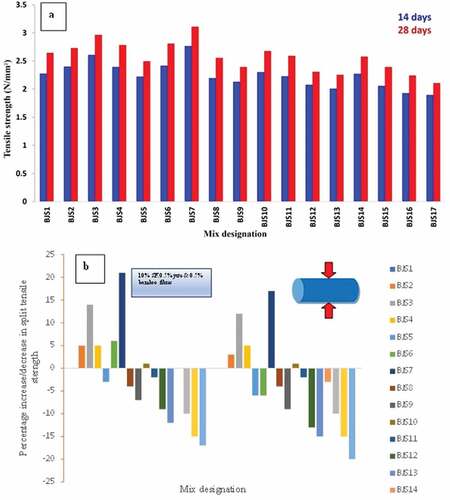
It is observed that the tensile strength of concrete improves with the addition of jute and bamboo fibers. However, the increment in tensile strength reduces because the percentage of fibers increases. This may be due to non-uniform dispersion of fibers leading to balling effect when more volume of fibers is added (Ramakrishna and Sundararajan Citation2019). The maximum tensile strength of 2.77 MPa is achieved for concrete with 0.5% jute and 0.5% bamboo fiber which is 21% more than that of control concrete specimen for 14 days curing. Tensile strength increases about 17% for 28 days of curing. Also, it is noted that the addition of bamboo fibers beyond 1% and jute fibers beyond 0.5% gives negative effect on the tensile strength. The reason behind this is the occurrence of unequal distribution of fiber in the mixture (Afreen Bashir et al. Citation2018). The negligible influence of jute fiber on tensile strength may be attributed to inadequate bridging effect, which causes fracture propagation on the surrounds concrete.
Flexural strength
Flexural strength of concrete with the addition of natural fiber is tested and depicted in . The flexural strength of various mix designations of concrete specimens with different combinations of jute and bamboo fibers and the percentage variations in the performance of specimens with respect to control concrete specimen are given in .
Figure 5. a) Flexural strength and b) percentage of increase/decrease in flexural strength of concrete with jute and bamboo fibers.
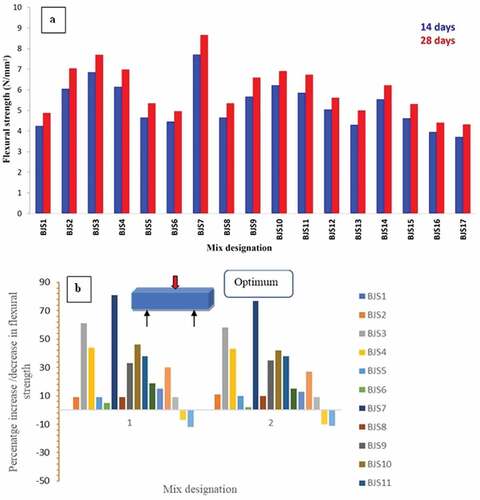
From , it is noted that the maximum flexural strength was attained (7.71 MPa in 14 days and 8.7 MPa in 28 days) with 0.5% jute and 0.5% bamboo fiber combination as like compressive and tensile strength. From the figure, it is noted that both jute and bamboo fibers are improving the flexural strength of concrete up to addition of 1% fibers. Beyond that, the strength is decreasing, and it is understood that the optimum proportion of 0.5% jute and 0.5% bamboo-fiber-reinforced concrete improves the flexural strength about 81% and 77% at 14 days and 28 days, respectively. Decrease in strength was observed because fiber addition was beyond 1.5% of bamboo and 1% of jute fibers. Flexural strength is increased due to the bridging and stitching effect of perfectly proportioned bamboo and jute fibers in concrete (Dewi, Narto Wijaya, and Christin Remayanti Citation2017). The addition of more fibers resulted in a decrease in flexural strength. This might be caused to fiber aggregation (Zakaria et al. Citation2017). The use of fiber contributes to the development of flexural strength in concrete with certain content and length (Sultana et al. Citation2020b). Sultana’s research reveals that the integration of fibers with the cement matrix has a significant influence on concrete flexural capacity. Furthermore, because the fiber agglomerates during the concrete mixing process, a consistent distribution of the fiber stack at greater components of fiber is not achievable, resulting in a reduction in the flexural strength of the concrete (Sultana et al. Citation2020a).
Prediction using NN
NN helps in predicting the strength of concrete using fibers with the available data. This analysis presents the forecast values of compressive strength, split tensile strength, and flexural strength values for the given input parameters such as concrete ingredients, fibers, percentage of bamboo and jute fibers and their composition. NN uses fiber blends extend by weight of the bamboo and jute fibers with 10% silica by weight of cement. The experimental results obtained for the concrete specimen incorporated with jute and bamboo fibers individually as well as with combinations are compared with the NN-predicted values. The mechanical properties are predicted by using NN types, namely NN-LM and NN-GD, in concrete with the different combination of bamboo and jute fibers with 10% SF. shows the comparing charts among actual values and predicted values of mechanical properties of the concretes.
Figure 6. Comparison of ANN predicted and actual values of (a) compression strength, (b) split tensile strength and (c) flexural strength.
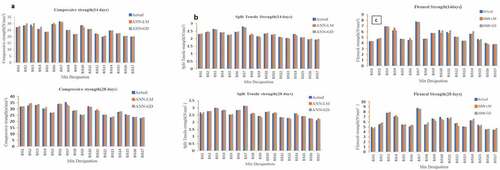
compares the actual and predicted compressive strength values of 17 different combinations of bamboo and jute fiber with 10% SF at 14 and 28 days. In NN-LM prediction, the maximum compressive strength was predicted for 0.5% jute fiber addition at 14 days of curing, which is only 4% higher than that of actual value. The minimum compressive strength was attained for BJS3, which is only 4% less than the actual value. Similarly, in case of 28 days of curing, the percentage increase in compressive strength was found to be maximum for BJS2, which is only 5% higher than actual value, and minimum is the BJS7, which is only 6% lesser than actual values. Similarly, for 28 days of curing, the maximum percentage increase of 6% for BSJ4 and BSJ7 is observed 6% lesser when compared to actual value. Similarly, for 14 and 28 days of curing, the percentage increase in anticipated compressive strength by NN-GD ranges from 1% to 6%. The percentage drop in anticipated compressive strength caused by NN-GD varies from 1% to 8% when cured for 14 days and from 1% to 9% when cured for 28 days.
The split tensile strength comparison between actual and projected values is shown in . The split tensile strength values were predicted using NN-LM analysis in 14 and 28 days of curing, which resulted in maximum percentage increase for BSJ8 that is 4% and 3% higher than the actual values, and percentage decrease in BSJ7 is 9% and 5% lesser than the actual values. Similarly, the projected values reveal that the maximum percentage rise for BSJ17 is 3% and 4% higher than the actual values, while the maximum percentage drop for BSJ7 is 9% and 7% lower than the actual values in NN-GD for 14 and 28 days of curing. The flexural strength of concrete after 14 and 28 days is compared in . The forecast values show that the maximum percentage increase was obtained for BSJ6, which is 8% and 7% higher than the actual values, respectively, in NN-LM analysis for 14 and 28 days of curing. The maximum percentage decrease of BSJ10 is 8% and 6% lower than the actual values, as being in the study carried out by Karthiyaini et al. (Citation2019). It is observed that the NN-LM and NN- GD predicted values are very closer and no significant difference was observed. When comparing the actual values with the predicted values, it was noted that the variation is within 10% and the optimum strength attained in the combined 0.5% jute and 0.5% bamboo fibers as like actuals.
Network performance and regression for ANN-LM and ANN-GD
A plot of MSE versus epoch was created as shown in for the ANN LM and ANN-GD compressive, split tensile and flexural strengths in training, testing and validation networks in order to choose the optimum ANN model. The epochs show that the number of times NN has been iterated through all possible data combinations in the graphic. More epochs mean more training-related computation time. It is evident that in the instance of ANN-LM, training stopped after 1 epoch for compressive strength, 2 epochs for tensile strength and 4 epochs for flexural strength after 28 days of curing. Three epochs for compressive strength and 5 epochs for tensile and flexural strength for 28 days of curing in the instance of ANN-GD 14 days of healing were followed by similar observations. High R values are indicated by the scatter plot in for training, validation, testing and total prediction. According to the figures, greater R values are obtained for concrete compressive strength, split tensile strength and flexural strength at 28 days of curing (R > 0.90) for both ANN-LM and ANN-GD. The high R values indicate that the ANN model created was both trustworthy and accurate in estimating the mechanical strengths of natural-fiber-reinforced concrete.
Figure 7. ANN-LM best validation for a) compressive strength, b) split tensile strength and c) flexural strength.
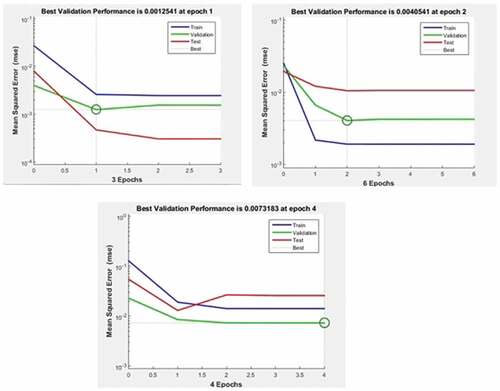
Figure 8. ANN-GD best validation for a) compressive strength, b) split tensile strength and c) flexural strength.
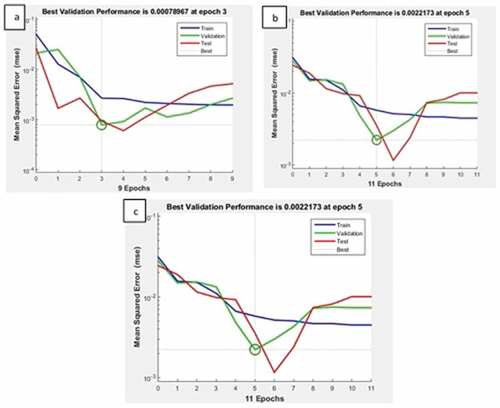
Comparison of proposed model with existing model
Response surface methodology
The methodology of response surfaces is a statistical and mathematical approach for improving and developing situations in which numerous influencing variables impact the result variables. From EquationEquations (4)(4)
(4) to (Equation9
(9)
(9) ), the current model is Response Surface Methodology employing the Box–Behnken design provided by Sridhar, Gobinath, and Serkan Kırgız (Citation2022).
where are concrete compressive strength, split tensile strength and flexural strength at 14 days and 28 days, respectively.
,
are jute, coconut fiber, and quarry dust, respectively.
shows the comparison of predicted compressive strength, split tensile strength and flexural for concrete at 28-day strength using ANN-LM, ANN-GD and RSM. It is evident that predicted results using ANN-LM and ANN-GD are having good agreement with response surface methodology. Nearly 95% of the results are in good agreement with existing models which indicates that proposed ANN-LM and ANN-GD are highly precise in predicting compressive strength, split tensile strength and flexural strength. Similar results were obtained for 14-day strength.
Concrete microstructure with scanning electron microscope
SEM examination was performed on the failing surface of concrete specimens containing 0.5% bamboo and 0.5% jute fibers and evaluated for compressive, tensile and flexural strength; the SEM images are displayed in . Understanding failure phenomena, such as interfacial bonding, cracks, voids, debonding or delamination of fibers and breaking of fibers, and how the fibers are shielding the concrete from failure to increase the load carrying capacity and mechanical properties of concrete would be made easier with the aid of these images. The SEM image of a failed specimen under compressive force is shown in .
Figure 12. SEM images at failure surface of tested FRC specimen: a) under compressive load, b) under split-tensile load and c) under flexure load.

According to the figure, the concrete specimen originally collapsed because of internal fractures and voids brought on by compression and crushing. Finally, fibers are broken, and fiber splitting is seen. Additionally, it is seen that there are no or very small cavities close to the fibers, which suggests that the concrete closer to the fibers is protected from crushing and a stronger link between the fibers and concrete matrix is assured.
depicts the SEM images at cracked surface of the failed concrete specimen under split tensile load. The SEM image clearly shows the pits, voids and disintegration of materials in concrete due to crushing and splitting of concrete. The cavities were also noted near fiber which may be due to the presence of entrapped air in the concrete. Also, it was observed that debonding of fibers in concrete is due to the reason that fiber is separated from concrete and hence failed to take up the further load as a composite. The failure may mainly be because of breaking of fiber with pulling force applied indirectly to the concrete cylinder. The SEM image of the concrete specimen’s broken surface under flexural load is shown in . Fibers can take higher load with less distortion because FRC has good flexural properties. Concrete cracks and circumferential fiber debonding are visible in the SEM image. It results from the bond between the fiber and concrete matrix weakening under flexural load. From the SEM images, it is clear how concrete and fibers fail with fiber failure resulting from pull-out and circumferential delamination under all three types of loads. Another observation is that the concrete matrix initially disintegrates, and cavities emerge before fiber debonding (Rajan et al. Citation2019). It is clear from SEM pictures that there is sufficient adhesion between the concrete matrix and fibers under all loads .
Conclusion
To test the combined effect of bamboo and jute fibers with SF in the concrete, an experimental examination was conducted. Additionally, using NN-LM and NN-GD approaches, the effect of fibers on the strength characteristics was anticipated in the concrete, and it was proven that the predicted values are significantly closer to the real values. The following list includes the key deductions drawn from the results.
When compared to other fiber combinations, concrete containing 0.5% bamboo fibers, jute fibers of 0.5% and SF 10% by weight of cement exhibits better compressive strength at 14 and 28 days after curing.
Bamboo fiber contributes to increasing the strength of concrete under compression much more than that of jute fiber. Jute and bamboo fiber additions over 1% have a detrimental effect on compressive strength.
For 14 and 28 days of curing, the concrete with bamboo fibers of 0.5%, jute fibers of 0.5%, and SF of 10% had the highest split tensile strength, which is 21% and 17% more than the control specimen.
The maximum percentage rise in flexural strength was obtained for 0.5% bamboo fibers, 0.5% jute fibers, and 10% SF after 14 and 28 days of curing, which is 81% and 77% greater than the control specimen.
Using NN-LM and NN-GD, the projected compressive strength, split tensile strength, and flexural strength are virtually identical to the actual values, with 10% difference.
The comparative results clearly indicate with Response Surface Methodology that suggested ANN model has high level of accuracy which can be used for the estimation of mechanical properties of natural-fiber-reinforced concrete.
SEM examination displayed the failure pattern of concrete and fibers and demonstrated a good connection between the fibers and the concrete matrix. The final collapse of the concrete specimen is caused by fiber breakage and debonding under pulling load.
Highlights
Jute and bamboo fibers in concrete with silica fume were evaluated.
It was summarized preparation of fiber-reinforced concrete.
Strengths and SEM were carried out on fiber-reinforced concrete.
Analysis was performed by various neural network softwares.
It was shown that there is a variation of 10% between strengths.
Disclosure statement
No potential conflict of interest was reported by the authors.
Data availability statement
The datasets generated during the current study are available from the corresponding author on request.
References
- Açikgenç, M., M. Ulaş, and K. Esat Alyamaç. 2014. Using an artificial neural network to predict mix compositions of steel fibre-reinforced concrete. Arabian Journal for Science and Engineering 40 (2):407–19. doi:10.1007/S13369-014-1549-X.
- Afreen Bashir, C. G., M. Abubakr, S. Abba, and A. SI. 2018. Analysis of bamboo fibre reinforced beam. Journal of Steel Structures & Construction 4 (2):146. doi:10.4172/2472-0437.1000146.
- Ajith, G., S. Kumar, and A. Elayaperumal. 2014. Experimental investigations on mechanical properties of jute fibre reinforced composites with polyester and epoxy resin matrices. Procedia Engineering 97 (January):2052–63. doi:10.1016/J.PROENG.2014.12.448.
- Amir, S., and D. Daniel, and Azar Bahman Farahmand. 2019. Prediction of bond strength between concrete and rebar under corrosion using ANN. Computers and Concrete 23(4): 273–79. doi:10.12989/cac.2019.23.4.273.
- Awoyera, P. O., A. V. Mehmet Serkan Kirgiz, D. Ovallos-Gazabon, and D. Ovallos-Gazabon. 2020. Estimating strength properties of geopolymer self-compacting concrete using machine learning techniques. Journal of Materials Research and Technology 9 (4):9016–28. doi:10.1016/J.JMRT.2020.06.008.
- Chandwani, V., V. Agrawal, and R. Nagar. 2014. Applications of artificial neural networks in modeling compressive strength of concrete: A state of the art review. Research Article International Journal of Current Engineering and Technology Accepted 4 (4):2949–56. doi:10.1155/2014/629137.
- Chopra, P., R. Kumar Sharma, and M. Kumar. 2016. Prediction of compressive strength of concrete using artificial neural network and genetic programming. Advances in Materials Science and Engineering 2016 (7648467):1–10. doi:10.1155/2016/7648467.
- Dayananda, N., K. Gowda, and E. Prasad. 2018. A study on compressive strength attributes of jute fibre reinforced cement concrete composites. IOP Conference Series: Materials Science and Engineering 376 (012069):012069. doi:10.1088/1757-899X/376/1/012069.
- Dewi, S. M., M. Narto Wijaya, and N. Christin Remayanti. 2017. The use of bamboo fibre in reinforced concrete beam to reduce crack. AIP Conference Proceedings, 1887. 020003. doi:10.1063/1.5003486.
- Dhanapal, J., and S. Jeyaprakash. 2020. Mechanical properties of mixed steel fibre reinforced concrete with the combination of micro and macro steel fibres. Structural Concrete 21 (1):458–67. doi:10.1002/SUCO.201700219.
- Fasihihour, N., J. Mohebbi, N. Abad, A. Karimipour, and M. Reza Mohebbi. 2022. Experimental and numerical model for mechanical properties of concrete containing fly ash: Systematic review. Measurement 188:110547. doi:10.1016/j.measurement.2021.110547.
- Gu, F., Y. Zheng, W. Zhang, X. Yao, D. Pan, A. Sze Mun Wong, J. Guo, P. Hall, and N. Sharmin. 2018. Can bamboo fibres be an alternative to flax fibres as materials for plastic reinforcement? A comparative life cycle study on polypropylene/flax/bamboo laminates. Industrial Crops and Products 121 (October):372–87. doi:10.1016/J.INDCROP.2018.05.025.
- Hodhod, O. A., M. S. Khalafalla, and M. S. M. Osman. 2019. ANN models for nano silica/silica fume concrete strength prediction. Water Science 33 (1):118–27. doi:10.1080/11104929.2019.1669005.
- Hussain, T., and M. Ali. 2019. Improving the impact resistance and dynamic properties of jute fibre reinforced concrete for rebars design by considering tension zone of FRC. Construction and Building Materials 213 (20 July 2019):592–607. doi:10.1016/J.CONBUILDMAT.2019.04.036.
- Islam, M. S., and S. J. Ahmed. 2018. Influence of jute fibre on concrete properties. Construction and Building Materials 189:768–76. doi:10.1016/j.conbuildmat.2018.09.048.
- Kalali, E. N., H. Yixin, X. Wang, L. Song, and W. Xing. 2019. Highly-aligned cellulose fibres reinforced epoxy composites derived from bulk natural bamboo. Industrial Crops and Products 129 (March 2019):434–39. doi:10.1016/J.INDCROP.2018.11.063.
- Karimipour, A., J. Mohebbi Najm Abad, and N. Fasihihour. 2021. Predicting the load-carrying capacity of GFRP-reinforced concrete columns using ANN and evolutionary strategy. Composite Structures 17:114470. doi:10.1016/j.measurement.2021.110547.
- Karthiyaini, S., K. Senthamaraikannan, J. Priyadarshini, K. Gupta, and M. Shanmugasundaram. 2019. Prediction of mechanical strength of fibre admixed concrete using multiple regression analysis and artificial neural network. Advances in Materials Science and Engineering 2019 (4654070):1–7. doi:10.1155/2019/4654070.
- Khan, M., and M. Ali. 2019. Improvement in concrete behavior with fly ash, silica-fume and coconut fibres. Construction and Building Materials 203.174–87. (10 April 2019). doi:10.1016/J.CONBUILDMAT.2019.01.103.
- Kim, J., C. Park, Y. Choi, H. Lee, and G. Song. 2012. An investigation of mechanical properties of jute fibre-reinforced concrete. RILEM Bookseries 2. 75–82. Springer. doi:10.1007/978-94-007-2436-5_10.
- Köksal, F., F. Altun, I. Yiǧit, and Y. Şahin. 2008. Combined effect of silica fume and steel fibre on the mechanical properties of high strength concretes. Construction and Building Materials 22 (8):1874–80. doi:10.1016/J.CONBUILDMAT.2007.04.017.
- Kumar, V. 2021. Strength characteristics of jute fibre composite concrete. International Journal of Engineering Research & Technology 5 (8):1–3.
- Kumar, G. S., and K. Rajasekhar. 2017. Performance analysis of Levenberg-Marquardt and steepest descent algorithms based ANN to predict compressive strength of SIFCON using manufactured sand. Engineering Science and Technology, an International Journal 20 (4):1396–405. doi:10.1016/J.JESTCH.2017.07.005.
- Kundu, S. P., S. Chakraborty, and S. Chakraborty. 2018. Effectiveness of the surface modified jute fibre as fibre reinforcement in controlling the physical and mechanical properties of concrete paver blocks. Construction and Building Materials 191 (10 December 2018):554–63. doi:10.1016/J.CONBUILDMAT.2018.10.045.
- Malathy, R., I. Min Chung, and M. Prabakaran. 2020. Characteristics of fly ash based concrete prepared with bio admixtures as internal curing agents. Construction and Building Materials 262 (30 November 2020):120596. doi:10.1016/j.conbuildmat.2020.120596.
- Marrero, R., H. Soto Toro, F. Benítez, C. Medina, and O. M. Suárez. 2017. Study of high-strength concrete reinforced with bamboo fibres. Materials for Energy, Efficiency and Sustainability: TechConnect Briefs 301–04.
- Momoh, E. O., and A. Israel Osofero. 2019. Behaviour of oil palm broom fibres (OPBF) reinforced concrete. Construction and Building Materials 221 (10 October 2019):745–61. doi:10.1016/J.CONBUILDMAT.2019.06.118.
- Pasnur, P. K., and S. B. Shetye. 2018. Effect of blend of silica fume and sisal fibre on performance of concrete. Journal of Advances and Scholarly Researches in Allied Education 15 (2):641–47. doi:10.29070/15/56944.
- Rahman, S., and A. Azad. 2018. Investigation on mechanical strength of jute fibre reinforced concrete (JFRC) compared to plain concrete. International Journal of Scientific Engineering Research 9:560–64.
- Rajan, A., S. Chitra, V. Hemapriya, I.M. Chung, S. H. Kim, and M. Prabakaran. 2019. Implications of eco-addition inhibitor to mitigate corrosion in reinforced steel embedded in concrete. Construction and Building Materials 213 (20 July 2019):246–56. doi:10.1016/J.CONBUILDMAT.2019.04.046.
- Ramakrishna, G., and T. Sundararajan. 2019, January. Long-term strength and durability evaluation of sisal fibre composites. In Durability and life prediction in biocomposites, fibre-reinforced composites and hybrid composites, 211–55. Woodhead Publishing Series in Composites Science and Engineering. doi:10.1016/B978-0-08-102290-0.00010-6.
- Sen, T., and J. Reddy. 2011. Application of sisal, bamboo, coir and jute natural composites in structural upgradation. International Journal of Innovation, Management and Technology 2 (3):186–91. doi:10.7763/IJIMT.2011.V2.129.
- Sofat, V., A. Khadwal, and S. Meerwal. 2017. An experimental study to check compressive strength of concrete by using jute fibres as reinforcement. International Journal of Earth Sciences and Engineering 10 (2):450–54. doi:10.21276/ijee.2017.10.0248.
- Sridhar, J., R. Gobinath, and M. Serkan Kırgız. 2022. Comparative study for efficacy of chemically treated jute fibre and bamboo fibre on the properties of reinforced concrete beams. Journal of Natural Fibres 19:12224–34. doi:10.1080/15440478.2022.2054894.
- Sultana, N., S. Z. Hossain, M. S. Alam, M. Hashish, and M. Islam. 2020b. An experimental investigation and modeling approach of response surface methodology coupled with crow search algorithm for optimizing the properties of jute fibre reinforced concrete. Construction and Building Materials 243:118216. doi:10.1016/j.conbuildmat.2020.118216.
- Sultana, N., S. Z. Hossain, M. S. Alam, M. Islam, and M. A. Al Abtah. 2020a. Soft computing approaches for comparative prediction of the mechanical properties of jute fibre reinforced concrete. Advances in Engineering Software 149:102887. doi:10.1016/j.advengsoft.2020.102887.
- Wahyuni, A. S., F. Supriani, Elhusna, and A. Gunawan, 2014. The performance of concrete with rice husk ash, sea shell ash and bamboo fibre addition. Procedia Engineering 95:473–78. doi:10.1016/J.PROENG.2014.12.207.
- Yan, L., N. Chouw, L. Huang, and B. Kasal. 2016. Effect oF alkali treatment on microstructure and mechanical properties of coir fibres, coir fibre reinforced-polymer composites and reinforced-cementitious composites. Construction and Building Materials 112 (01 June 2016):168–82. doi:10.1016/J.CONBUILDMAT.2016.02.182.
- Zakaria, M., M. Ahmed, M. Mozammel Hoque, and A. Hannan. 2015. Effect of jute yarn on the mechanical behavior of concrete composites. SpringerPlus 4 (1):1–8. doi:10.1186/s40064-015-1504-7.
- Zakaria, M., M. Ahmed, M. Mozammel Hoque, and S. Islam. 2017. Scope of using jute fibre for the reinforcement of concrete material. Textiles and Clothing Sustainability 2 (1):1–10. doi:10.1186/S40689-016-0022-5.


